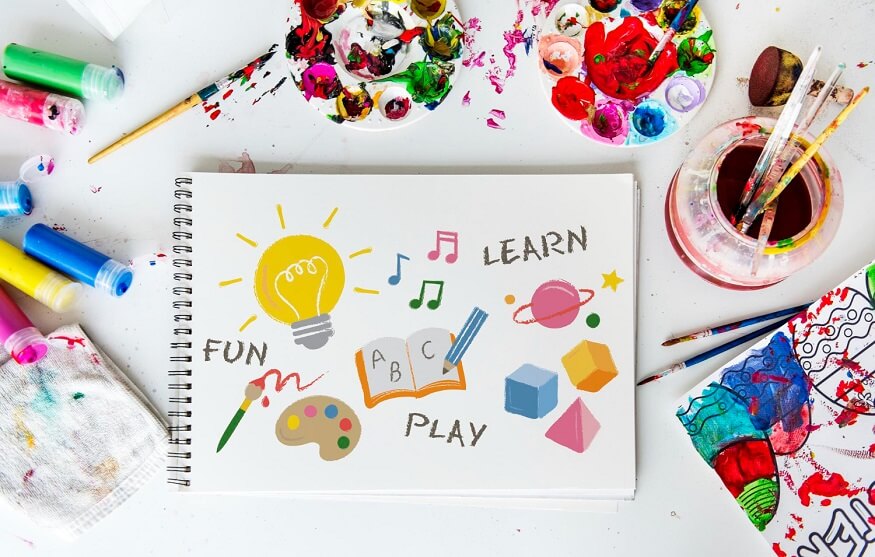Creativity is a crucial aspect of a child’s developmental journey. It is the driving force behind shaping perceptions, abilities and a skill that significantly influences their cognitive, emotional and social well-being. Developing creativity in early years builds children’s problem-solving abilities, enhances their divergent thinking, boosts self-expression and self-esteem and fosters an appreciation of the diversity that exists around them. One stream that promises to stimulate this creativity is art education.
Einstein once famously stated,
“Imagination is more important than knowledge. For knowledge is limited, whereas imagination embraces the entire world”.
This quote underscores the value of creativity, a skill that art education is uniquely poised to develop. Art is a language that speaks to the imagination and fosters enhanced cognitive development.
Art education combines aspects of visual as well as performing arts. It includes streams such as music, dance, painting, sculpture and theatre. In this blog, we will explore how introducing children to arts education in their primary-level developmental years can provide a platform for creative thinking and innovation.
Understanding creativity
Creativity is the ability to generate new ideas, think divergently and express one’s thoughts in unique and imaginative ways. Children are naturally creative beings from the time they are born. They require a bit of nurturing and cultivating the creative skills that will serve them well throughout their lives.
Benefits of nurturing creativity through art
Multiple research studies have reinforced the link between art education and enhanced creativity in children.
A report by the National Endowment for the Arts (2015) found that art education can stimulate a “whole-child” development approach. This approach includes, among other things, the promotion of creativity, self-direction, cognitive skills, and problem-solving abilities, all nurtured by the inclusion of arts in primary education.
Engaging in artistic pursuits promotes higher-order thinking skills such as analysis, synthesis, and evaluation. These are the cornerstone of creativity. Art helps develop a child’s ability to interpret and make sense of the world around them.
By encouraging children to express themselves in a non-verbal and non-structured format, art education can help children imagine and create beyond the traditional boundaries of learning, boosting their creative capacities.
1) Enhanced problem solving: Children who are exposed to various forms of art from a young age, develop the ability to find alternate solutions to problems, challenge assumptions and view problems from different perspectives. Whether it is making an artistic piece, or creating a story, children learn to collaborate, share ideas, solve problems, think critically and appreciate diverse perspectives.
2) Better Spatial Reasoning: Drawing, painting, and sculpture are art forms that require spatial awareness. These art forms enhance children’s spatial reasoning abilities which are useful in the field of mathematics and engineering.
3) Fine motor skills: Creativity intertwines with other critical skills, making it necessary for holistic child development. For example, amidst the chaos of lines, shapes, and colours in children’s artwork lies the potential to enhance observation skills, imagination, fine motor skills, focus, and patience. Intricate forms of art and activities such as cutting, painting, and moulding, require hand-eye coordination. This refines their motor skills.
4) Enhanced emotional expression: Art serves as a non-verbal medium of expressing emotions. Children who find it difficult to express themselves in words use art to communicate their emotions such as happiness, sadness, anger, or excitement. As they learn to recognise and acknowledge their emotions, children become more self-aware and learn to deal with the emotions they feel.
5) Collaboration and cooperation: Art projects involving group work allows them to share ideas, discuss, debate, weigh options and take decisions together. They learn the value of being collaboratively creative when working in a team and respecting diverse perspectives.
6) Effective communication skills: During their art sessions, children learn to listen to each other, discuss their creative choices, and express their views. This not only enhances their communication skills; it also builds their confidence to articulate their thoughts in a public setting.
7) Exposure to diverse cultural perspectives: Art exposes children to different cultures and art styles. Hence, children develop an open-minded approach to the cultural diversity around them while accepting and respecting creative differences across various regions globally.
8) Develops individuality: Art education allows children to experiment and explore their ideas without any guidelines or rules. As a result, they develop their unique style. Art education provides children with the opportunity to step out of their comfort zone and take creative risks. Through art, they feel appreciated for their individuality and creative choices. This boosts their self-esteem and fosters a feeling of accomplishment.
9) Encourages experimentation and exploration: Using a wide variety of artistic tools, techniques and props be it painting, drawing, sculpting or performing, allows them to experiment and find mediums that appeal to their interest and taste. It also encourages them to think creatively about how to use these materials to bring their ideas to life.
10) Cultivates creative resilience: As children explore and experiment, they may not always get the desired outcome in their artistic endeavours. Art allows them to adapt and try again and this builds their ability to be resilient in moments of frustration or disappointment. It also teaches them to be creatively resilient during moments of failure or fear and find solutions to their problems.
Conclusion
Art education in school sparks children’s imagination and shifts their focus on enjoying the process of creation – not just the result. Just the act of making art fosters creativity, as children learn to explore, make mistakes, and find solutions. This focus helps them develop a growth mindset, which values effort and progress, enhancing resilience and adaptability. Incorporating art education into the curriculum will provide a solid foundation for personal and academic success. Art education equips children to think outside the box and express their thoughts and feelings creatively which is a critical skill for children to prepare them for the future.
EuroSchool is committed to providing a comprehensive and enriching art education that nurtures creativity, imagination, and self-expression in its students. By integrating art across the curriculum and fostering a supportive environment, EuroSchool empowers students to explore their artistic potential, build confidence, and develop essential life skills that will serve them well in their future endeavours.










